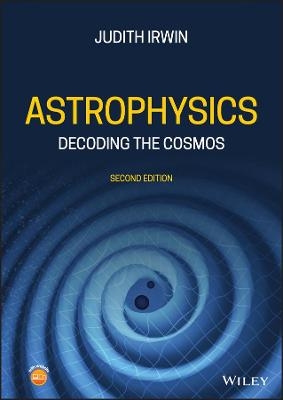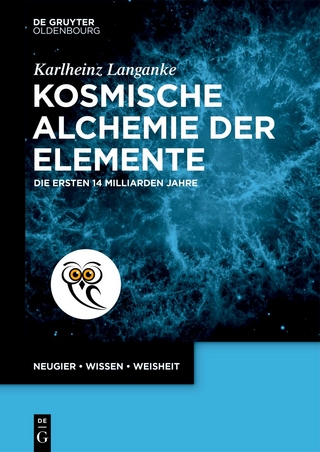
Astrophysics – Decoding the Cosmos
Wiley-Blackwell (Verlag)
978-1-119-62368-7 (ISBN)
Astrophysics: Decoding the Cosmos, Second Edition, describes how information about the physical nature of stars and other celestial bodies is obtained and analyzed to gain a better understanding of the universe. This acclaimed introductory textbook makes the complex principles and theories underlying astrophysics accessible to students with basic knowledge of first-year calculus-based physics and introductory astronomy. Reader-friendly chapters explore physical processes using relevant examples and clear explanations of how radiation and particles are analyzed. Such analysis leads to the density, temperature, mass, and energy of astronomical objects.
In the time since the first publication of Astrophysics, the power of telescopes has increased considerably. Reflecting advancements in the field, this new edition includes carefully reviewed and updated material throughout, including recent GAIA satellite results, new information from subatomic particles, neutrinos, and cosmic rays, and brand-new case studies on Gamma-ray bursters, soft repeaters, fast radio bursts, exoplanets, and signals from exoplanetary atmospheres. Retaining its focus on electromagnetic radiation, the second edition now covers more of the ways that information about the universe is acquired, such as particles, gravitational radiation, and meteoritics. This textbook:
Describes complex processes in a clear and accessible manner
Provides relevant background information on the physics and examples of the theory in practice to place the subject into context
Includes new figures, case studies, examples, further readings, end-of-chapter problems of varying difficulty levels, and open-ended “Just for Fun” problems
Features a companion website containing information required to solve the designated web-based problems in the text and a range supplementary learning material
Astrophysics: Decoding the Cosmos, Second Edition, is the ideal intermediate textbook for second- and third-year undergraduate students in Astrophysics courses, as well as a useful resource for advanced undergraduate and graduate students looking to refresh their knowledge in basic concepts.
Judith Irwin is an Astrophysicist and Professor of Physics and Astronomy at Queen’s University, Canada, where she teaches undergraduate and graduate level physics, astrophysics, and astronomy. Her research focuses on gaseous halos and magnetic fields that surround spiral galaxies. Professor Irwin has published numerous papers in peer-reviewed scientific journals.
Preface to the 1st edition xiii
Preface to the 2nd edition xv
Acknowledgments – 1st Edition xvii
Acknowledgments – 2nd Edition xix
List of Symbols xxi
About the Companion Website xxiii
Introduction xxv
I.1 Dimensions, Units and Equations xxix
Problems xxxiv
Just for Fun xxxiv
Part I: The Nonelectromagnetic Signal 1
Chapter 1: The Particles: Macroscopic to Subatomic 3
1.1 Meteoritics 4
1.1.1 Dating Meteorites 7
1.1.2 Infrasound 9
1.1.3 Gathering Dust 15
1.2 Cosmic Rays 17
1.2.1 Cosmic Ray Composition 18
1.2.2 The Cosmic Ray Energy Spectrum 19
1.2.3 The Origin of Primary Cosmic Rays 23
1.3 Neutrinos 25
1.3.1 The Neutrino Spectrum 27
1.3.2 Astrophysics with Neutrinos 30
Problems 32
Just for Fun 35
Chapter 2: Gravitational Radiation: A New Window 37
2.1 Concepts of Relativity 37
2.2 The Fabric of Space–Time 38
2.3 Curved Space–Time near a Mass 40
2.4 Gravitational Waves 43
2.5 GWs from Binary Orbits 45
2.6 Evolution of a Binary Orbit 48
2.6.1 The Inspiral 48
2.6.2 The ‘Death-Spiral’ 51
2.7 Indirect Proof of the Existence of Gravitational Waves 53
2.8 Direct Proof of the Existence of Gravitational Waves 55
2.9 Even Newer Windows 58
Problems 59
Just for Fun 60
Part II: The EM Signal Observed 63
Chapter 3: Defining the Signal 65
3.1 The Power of Light – Luminosity and Spectral Power 65
3.2 Light Through a Surface – Flux and Flux Density 69
3.3 The Brightness of Light – Intensity and Specific Intensity 72
3.4 Light from All Angles – Energy Density and Mean Intensity 78
3.5 How Light Pushes – Radiation Pressure 80
3.6 The Human Perception of Light – Magnitudes 83
3.6.1 Apparent Magnitude 83
3.6.2 Absolute Magnitude 86
3.6.3 The Colour Index and Bolometric Correction 86
3.6.4 Gaia and the HR Diagram 87
3.6.5 Magnitudes Beyond Stars 90
3.7 Light Aligned – Polarization 90
Problems 91
Just for Fun 95
Chapter 4: Measuring the Signal 97
4.1 Spectral Filters and the Panchromatic Universe 97
4.2 Catching the Signal – The Telescope 100
4.2.1 Collecting and Focussing the Signal 103
4.2.2 Detecting the Signal 105
4.2.3 Field of View and Pixel Resolution 107
4.2.4 Diffraction and Diffraction-limited Resolution 107
4.2.5 Weighting the Aperture – Interferometry 109
4.3 The Corrupted Signal – The Atmosphere 113
4.3.1 Atmospheric Refraction 113
4.3.2 Seeing 114
4.3.3 Adaptive Optics 118
4.3.4 Scintillation 121
4.3.5 Atmospheric
Reddening 121
4.4 Processing the Signal 122
4.4.1 Correcting the Signal 122
4.4.2 Calibrating the Signal 123
4.5 Analysing the Signal 123
4.6 Visualizing the Signal 125
4.7 Comparing Signals in Disparate Wavebands 129
Problems 130
Just for Fun 132
Part III: Matter and Radiation Essentials 133
Chapter 5: Matter Essentials 135
5.1 The Big Bang 135
5.2 Dark and Light Matter 136
5.3 Abundances of the Elements 141
5.3.1 Primordial Abundance 141
5.3.2 Stellar Evolution and ISM Enrichment 141
5.3.3 Supernovae and Explosive Nucleosynthesis 146
5.3.4 Abundances in the MilkyWay, Its Star Formation History and the IMF 149
5.4 The Gaseous Universe 154
5.4.1 Kinetic Temperature and the Maxwell–Boltzmann Velocity Distribution 157
5.4.2 The Ideal Gas 159
5.4.3 The Mean Free Path and Collision Rate 162
5.4.4 Statistical Equilibrium, Thermodynamic Equilibrium, and Local Thermodynamic Equilibrium 165
5.4.5 Excitation and the Boltzmann Equation 169
5.4.6 Ionization and the Saha Equation 173
5.4.7 Probing the Gas 174
5.5 The Dusty Universe 176
5.5.1 Observational Effects of Dust 177
5.5.2 Structure and Composition of Dust 182
5.5.3 The Origin of Dust 184
Problems 185
Just for Fun 187
Chapter 6: Radiation Essentials 189
6.1 Black Body Radiation 189
6.1.1 The Brightness Temperature 193
6.1.2 The Rayleigh–Jeans law and Wien’s law 195
6.1.3 Wien’s Displacement law and Stellar Colours 197
6.1.4 The Stefan–Boltzmann law, Stellar Luminosity and the HR Diagram 199
6.1.5 Energy Density and Pressure in Stars 200
6.2 Grey Bodies and Planetary Temperatures 201
6.2.1 The Equilibrium Temperature of a Grey Body 204
6.2.2 Exoplanets and Their Detection 209
Problems 213
Just for Fun 217
Part IV: The EM Signal Perturbed 219
Chapter 7: The Interaction of Light with Matter 221
7.1 The Photon Redirected – Scattering 222
7.1.1 Elastic Scattering 226
7.1.2 Inelastic Scattering 234
7.2 The Photon Lost – Absorption 238
7.2.1 Particle Kinetic Energy – Heating 238
7.2.2 Change of State – Ionization and the Strömgren Sphere 239
7.3 The Wavefront Redirected – Refraction 242
7.4 Quantifying Opacity and Transparency 245
7.4.1 Total Opacity and the Optical Depth 245
7.4.2 Dynamics of Opacity – Pulsation and Stellar Winds 249
7.5 The Opacity of Dust – Extinction 253
Problems 255
Just for Fun 259
Chapter 8: The Signal Transferred 261
8.1 Types of Energy Transfer 261
8.2 The Equation of Transfer 263
8.3 Solutions to the Equation of Transfer 265
8.3.1 Case A: No Cloud 265
8.3.2 Case B: Absorbing, but Not Emitting Cloud 266
8.3.3 Case C: Emitting, but Not Absorbing Cloud 266
8.3.4 Case D: Cloud in Thermodynamic Equilibrium (TE) 267
8.3.5 Case E: Emitting and Absorbing Cloud 267
8.3.6 Case F: Emitting and Absorbing Cloud in LTE 268
8.4 Implications of the LTE Solution 268
8.4.1 Implications for Temperature 268
8.4.2 Observability of Emission and Absorption Lines 269
8.4.3 Determining Temperature and Optical Depth of HI Clouds 276
Problems 279
Just for Fun 280
Chapter 9: The Interaction of Light with Space 281
9.1 Redshifts and Blueshifts 282
9.1.1 The Doppler Shift – Deciphering Dynamics 282
9.1.2 The Expansion Redshift 291
9.1.3 The Gravitational Redshift 294
9.2 Gravitational Refraction 295
9.2.1 Geometry and Mass of a Gravitational Lens 296
9.2.2 Microlensing – MACHOs and Planets 301
9.2.3 Cosmological Distances with Gravitational Lenses – Time Delays and H0 303
9.3 Time Variability and Source Size 305
9.4 A Brief Coda 305
Problems 306
Just for Fun 310
Part V: The EM Signal Emitted 311
Chapter 10: Continuum Emission 313
10.1 Characteristics of Continuum Emission – Thermal and Nonthermal 314
10.2 Bremsstrahlung (Free–Free) Emission 315
10.2.1 The Thermal Bremsstrahlung Spectrum 316
10.2.2 Radio Emission from HII and Other Ionized Regions 321
10.2.3 X-ray Emission from Hot Diffuse Gas 325
10.3 Free–Bound (Recombination) Emission 332
10.4 Two-Photon Emission 335
10.5 Synchrotron (and Cyclotron) Radiation 336
10.5.1 Cyclotron Radiation – Planets to Pulsars 339
10.5.2 The Synchrotron Spectrum 345
10.5.3 Determining Synchrotron Source Properties 349
10.5.4 Synchrotron Sources – Spurs, Bubbles, Jets, Lobes, and Relics 353
10.6 Inverse Compton Radiation 356
Problems 360
Just for Fun 363
Chapter 11: Line Emission 365
11.1 The Richness of the Spectrum – RadioWaves to Gamma Rays 366
11.1.1 Electronic Transitions – Optical and UV Lines 366
11.1.2 Rotational and Vibrational Transitions – Molecules, IR and mm-Wave Spectra 367
11.1.3 Nuclear Transitions – 𝛾-Rays and High Energy Events 371
11.2 The Line Strengths, Thermalization, and the Critical Gas Density 376
11.3 Line Broadening 378
11.3.1 Doppler Broadening and Temperature Diagnostics 378
11.3.2 Pressure Broadening 382
11.4 Probing Physical Conditions Via Electronic Transitions 384
11.4.1 Radio Recombination Lines 384
11.4.2 Optical Recombination Lines 390
11.4.3 The 21Cm Line of Hydrogen 394
11.5 Probing Physical Conditions Via Molecular Transitions 398
11.5.1 The Carbon Monoxide (CO) Molecule 399
Problems 401
Just for Fun 403
Part VI: The Signal Decoded 405
Chapter 12: Forensic Astronomy 407
12.1 Complex Spectra 408
12.1.1 Isolating the Signal 408
12.1.2 Modelling the Signal 410
12.2 Case Studies – The Active, the Young, and the Old 415
12.2.1 Case Study 1: The Galactic Centre (the Active) 415
12.2.2 Case Study 2. The Cygnus Star-Forming Complex (the Young) 419
12.2.3 Case Study 3: The Globular Cluster, NGC 6397 (the Old) 422
12.3 The Messenger and the Message 426
Problems 427
Just for Fun 429
Appendix T 431
Acronym Key to Bibliography 441
References and In-Depth Reading 442
Index 467
| Erscheinungsdatum | 07.05.2021 |
|---|---|
| Verlagsort | Hoboken |
| Sprache | englisch |
| Maße | 181 x 264 mm |
| Gewicht | 1224 g |
| Themenwelt | Naturwissenschaften ► Physik / Astronomie ► Astronomie / Astrophysik |
| ISBN-10 | 1-119-62368-5 / 1119623685 |
| ISBN-13 | 978-1-119-62368-7 / 9781119623687 |
| Zustand | Neuware |
| Informationen gemäß Produktsicherheitsverordnung (GPSR) | |
| Haben Sie eine Frage zum Produkt? |
aus dem Bereich


